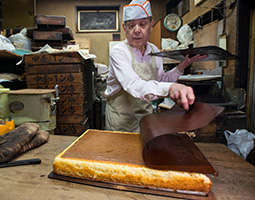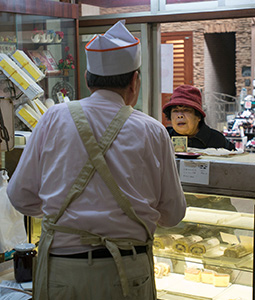Home > Highlighting JAPAN > Highlighting Japan April 2018 > Washoku
Highlighting JAPAN


Kasutera: A Simple Yet Subtle Sweet Treat
Though still inextricably linked with Nagasaki in the Kyushu region, the sponge cake kasutera is a firm favorite across Japan — and with people of all ages.
Taizo Fuchuya whips the whites of two dozen eggs in a large steel container while holding a pan of boiling water underneath. In the cooler months, he says, this helps to enhance the whipping process, a process known as betsudate-ho (“separated whipping method”) that is crucial to the making of his product, but is, by his own admission, no piece of cake.
“A lot depends on this stage of the process, which can be affected greatly by temperature, the seasons and the weather,” explains Fuchuya, 68, whose Castella Nakaya in downtown Tokyo specializes in kasutera and has been in operation for over a century. “I’ve been making these for forty-five years, and I still worry if it will come out OK.”
Rather than the decorative flour-and-cream-based cakes and gateaux found in the West, Japan is better known for wagashi (Japanese sweets) (see here), the most representative of which are made from kanten (agar), or a glutinous rice called mochi and are often paired with a paste made from sweetened azuki beans.
One notable exception is kasutera, or in its non-transliterated form, Castella, whose apparent simpleness belies a surprisingly nuanced and difficult to perfect dessert. It is also Japan’s oldest sponge cake, even though its origins are not found in Japan.
It is widely held that kasutera was first introduced to Japan in the sixteenth century by Portuguese merchants during Japan’s so-called Nanban boeki (Japanese trade with Spain and Portugal) period, following the opening of the port in Nagasaki, which was then a tiny fishing village in Kyushu, but is today a city of 400.000 people with which the cake remains inextricably linked.
Legend has it that when asked by locals what the cake was, Portuguese merchants referred to it as “Bolo (dessert) de Castilla” or “Pao (bread) de Castilla” — Castilla being the Portuguese word for Castile, a former kingdom on the Iberian Peninsula that continues to exist, albeit unofficially, as a roughly defined region in Spain that encompasses Leon, La Mancha and Madrid.
According to the book Nanban boeki to kasutera (Nanban trade and kasutera), published by Fukusaya, a 400-year-old kasutera maker in Nagasaki, one explanation for the roots of this “Bolo” or “Pao” can be found in a hard bread, or “biscuit” known in Spain as “bizcocho.” This started off primarily as a subsistence food for the Spanish Navy around 1,000 years ago, but also spawned a variant that is closer in consistency to the kasutera we know today, says the book.
Another connection linking Nagasaki kasutera and bizcocho can be found in the meaning of the Castillian word — “bake twice.”
According to Fuchuya, kasutera, too, requires two bakings: the first to give the cake its familiar deep brown top and bottom; the second to make the mixture rise.
The ingredients of that mixture are relatively straightforward. Once the egg whites are mixed to an adequately fluffy consistency, the yolks are added followed by three different types of sugar — zarame-tou (course ground), castor and mizuame (a starch-based sweetener) — and, finally, flour.
This is baked in an oven heated to around 200°C for approximately 5 minutes before being baked again at a lower heat to to complete the rising process. It is then left overnight, not just to cool but to draw out the characteristic flavors of the cake, according to Fuchuya.
“Fresh out of the oven, it actually doesn’t taste so great,” he says as he dons a pair of well-used oven gloves and takes a peek inside the oven at his creation, which is baked inside an oven-paper lined wooden frame about the size of a large chess board. “Allowing it to rest overnight returns the sweetness and deepens the flavor.”
That depth and sweetness is augmented by the use of the zarame-tou, which Fuchuya says is responsible for the wonderfully grainy, caramelly sensation that hits the tongue from the bottom of the cake.
“The biggest appeal of kasutera is its simple, but subtle taste that can be enjoyed by people of all ages,” says a customer at Castella Nakaya.
Today kasutera can be found even outside Japan, gaining a popular following in Asian countries such as Taiwan, Singapore and Indonesia. There are even kasutera shops in Portugal that have opened up over the past couple of decades. Introduced by Portuguese merchants centuries ago and now all-powerful in Japan, the day may soon arrive when kasutera delights taste buds around the world.
© 2009 Cabinet Office, Government of Japan










